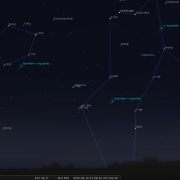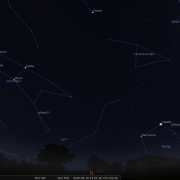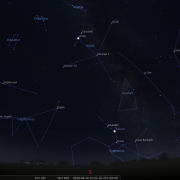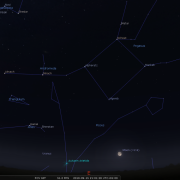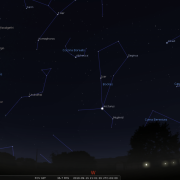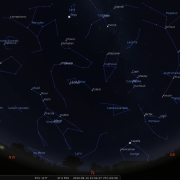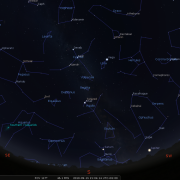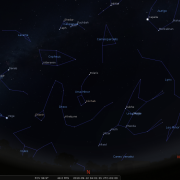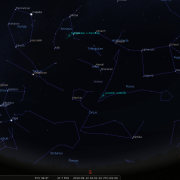In this month's Sky Notes:
- Planetary Skylights
- Meteors (lack of...)
- Comet 2018 W2 (Africano)
- Autumnal Equinox 2019
- September 2019 Sky Charts
Planetary Skylights
Jupiter and Saturn remain the dominant planets throughout September, although they are not the only gas giant planets present in the late evening sky, however Uranus and Neptune will definitely require a telescope just to verify them as anything other than faint stars.

Located quite low to the SW in the Southern-most reaches of Ophuichus, Jupiter requires minimal magnification to discern its bright ‘sixpence’ like disk through the eyepiece. Observations will be compromised somewhat due to the low altitude, but during moments of good ‘seeing’, Jupiter is a wonderful target. Look for the ‘belts’ and Great Red Spot (when visible) as well as the Galilean moons, seen as bright specks of light in vicinity of Jupiter, presenting a different configuration each night. By the end of September Jupiter is setting before 20:30h so make the most of any observing opportunities. The Moon lies closest to Jupiter on the 6th.
Because the period in which to observe Jupiter is diminishing as it nears the end of its apparition, the following Great red spot visibility times are all for 20:00-21:00h BST:
- 1st, 3rd, 8th, 13th, 18th, 20th, 23rd, 25th, and 30th.
Galilean moon shadow transits also visible 20:00-21:00h.
- 4th: Europa shadow transit
- 6th: Io shadow and moon transit
- 22nd: Io shadow transit (20:15h)
Top: 05-Sep-2019 at 20:45h Looking South: Saturn, The Moon and Jupiter
Bottom: 08-Sep-2019 at 21:00h Looking South: Saturn and The Moon
(Click picures for full-sized image)

 Following Jupiter across the South, Saturn is now best placed for observations at a convenient hour. Resembling a fairly bright pearly star of magnitude Mag +0.2, Saturn resides above the South horizon in the constellation of Sagittarius. Suffering from the same ‘unsteady seeing’ problem as Jupiter, your patience at the eyepiece will ultimately be rewarded with the ring system evident in modest telescopes. The two main rings A and B are the most evident separated by the Cassini ‘gap’. Look also for Saturn’s largest moon; Titan, visible as a speck of light nearby. Our Moon lies in proximity to Saturn in the sky on the 8th.
Following Jupiter across the South, Saturn is now best placed for observations at a convenient hour. Resembling a fairly bright pearly star of magnitude Mag +0.2, Saturn resides above the South horizon in the constellation of Sagittarius. Suffering from the same ‘unsteady seeing’ problem as Jupiter, your patience at the eyepiece will ultimately be rewarded with the ring system evident in modest telescopes. The two main rings A and B are the most evident separated by the Cassini ‘gap’. Look also for Saturn’s largest moon; Titan, visible as a speck of light nearby. Our Moon lies in proximity to Saturn in the sky on the 8th.
 Neptune reaches opposition this month (10th) residing in the constellation of Aquarius close by the star Phi aqr. You will require a telescope to spot its diminutive disk, which is fainter than all visible naked eye stars, but it does appear decidedly blue grey in hue. If skies are clear on the 6th and 7th, Neptune lies right next to Phi aqr and if you have a 10” scope or larger you should be able to pick out Triton, Neptune’s largest moon between it and phi aqr.
Neptune reaches opposition this month (10th) residing in the constellation of Aquarius close by the star Phi aqr. You will require a telescope to spot its diminutive disk, which is fainter than all visible naked eye stars, but it does appear decidedly blue grey in hue. If skies are clear on the 6th and 7th, Neptune lies right next to Phi aqr and if you have a 10” scope or larger you should be able to pick out Triton, Neptune’s largest moon between it and phi aqr.

06-Sep-2019 2100: The Moon, φAquarii (the star), Triton, Neptune.
 Uranus resides in the Southern reaches of Aries, and is best observed later in the night when higher to the south, but you will find it above the east horizon at 22:00h forming a triangle with Torcular in Pisces and Al Kaff al Jidmah I in Cetus. Look for a small grey green disk.
Uranus resides in the Southern reaches of Aries, and is best observed later in the night when higher to the south, but you will find it above the east horizon at 22:00h forming a triangle with Torcular in Pisces and Al Kaff al Jidmah I in Cetus. Look for a small grey green disk.


 Mars, Mercury and Venus are all lost in solar glare this month.
Mars, Mercury and Venus are all lost in solar glare this month.
Meteors

No notable meteor showers this month. Sorry everyone!
Comet 2018 W2 (Africano)
This comet will not be a naked eye object, but should be visible in binoculars or small scopes. It is also well placed for northern hemisphere observers, tracking through Perseus, Andromeda and Pegasus during September.
The comet reaches perihelion (closest to sun) on Sept 6th when around 5 degrees below the double cluster in Perseus. At an estimated magnitude of +10.5, it will then track down through Andromeda, passing through the bottom left-hand quadrant of the Square of Pegasus by the 26th, when it may be a magnitude or two brighter. Yep, not spectacular, but you never know with comets.
Autumnal Equinox 2019

By astronomical convention autumn officially commences in the northern hemisphere on the date of the Autumnal Equinox, when from our perspective the Sun re-crosses the celestial equator and heads south, arcing ever lower above the south horizon.
This year the date of the equinox again falls on September 23rd. For the second time in its orbit around the Sun, neither of Earths poles is inclined towards our nearest star with hours of daylight and darkness almost equal across the whole planet. As the northern hemisphere continues to tilt away from the Sun, evenings will rapidly draw in once again as we head toward winter. Cheery thought!
September 2019 Sky Charts
|
Looking North
Mid-September - 21:00h |
Looking South |
|
Looking East
Mid-September - 21:00h |
Looking West
Mid-September - 21:00h |
|
Northern Aspect
Mid-September - 21:00h |
Southern Aspect
Mid-September - 21:00h |
| Looking North (Early) Mid-September - 04:00h |
Looking South (Early) Mid-September - 04:00h |
Additional Image Credits:
- Planets and Comets where not otherwise mentioned: NASA
- Sky Charts: Stellarium Software
- Log in to post comments




